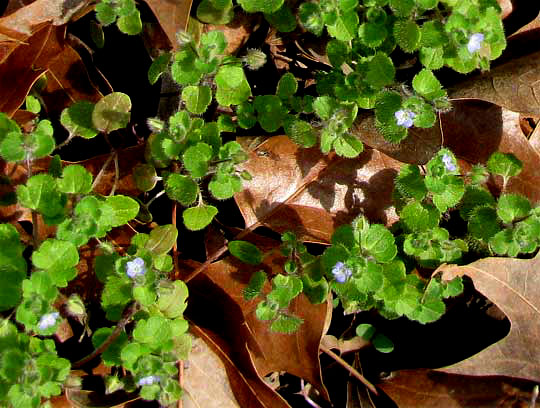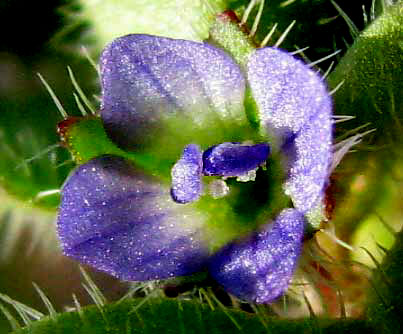Excerpts from Jim Conrad's
Naturalist Newsletter
from the February 2, 2009 Newsletter, issued from the forest near Natchez, Mississippi; elevation ~400ft (120m), ~N31.47°, ~W91.29°:
IVY-LEAVED SPEEDWELL FLOWERING
In the lawn around Karen's house the most conspicuous, wild flowering plant is the tiny, weak-stemmed, rambling Ivy-leaved Speedwell, VERONICA HEDERAEFOLIA, shown below:

Most folks wouldn't notice this little annual plant because it's so small -- the pale lilac flowers in the picture less than 1/10th inch wide -- and commonplace. At this time of year it peeps from beneath last year's leaves, which protect it from the cold during its germination stage. As spring progresses the sprawling stems will wander all over the place, eventually forming a luxuriant, bright yellow-green carpet, very pretty to see after a long winter.

At the right you see a close-up of the Ivy-leaved Speedwell's neat little flower. This blossom's basic anatomy is good to know because there are lots of weedy speedwells -- about 35 species of the genus Veronica -- so later you may need to distinguish species by comparing their floral structure.
In the picture you see a corolla consisting of four pale-violet lobes barely attached at their bases. If you're very careful you can remove the four-lobed corolla in one piece. Note the two darker, petal-like items in the corolla's center. Species of the genus Veronica bear only two stamens (male parts), and that's what those are. The white, granular material at the sides of the incurving, violet-colored things is pollen.
Veronica flowers are slightly "irregular" -- they're not perfectly symmetrical. Notice that the topmost lobe is broader than the lowest lobe. In Veronica flowers the two stamens arise from the base of the topmost lobe. These features, especially because the flowers are so tiny, are very subtle, but in the world of botany they're important.
In the old days, Speedwells/Veronicas were placed in the big Figwort or Snapdragon Family, the Scrophulariaceae, but nowadays most specialists assign them to the Plantain Family, the Plantaginaceae.
The Ivy-leaved Speedwell in the picture is an invasive originally from Europe, but I hold no grudge against it. In these early spring days with their tender, yellow-green leaves and little bursts of blue in an otherwise brown and gray world, they are most welcome around my door.
By the way, with a name like speedwell you might reckon that Vernonicas are medicinal. In England our Ivy-leaved Speedwell has a history of being used against scurvy and "impurities of the blood." Its bruised herbage can be applied to burns, ulcers, whitlows and hemorrhoids." Whitlows are fingernail infections.